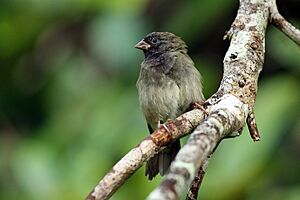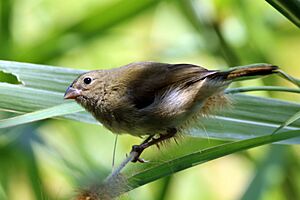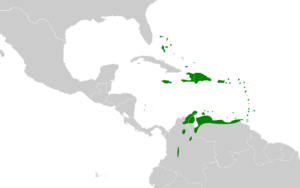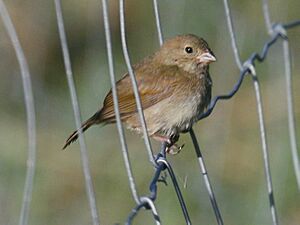Black-faced grassquit facts for kids
Quick facts for kids Black-faced grassquit |
|
|---|---|
 |
|
| Male, Jamaica | |
 |
|
| Female, Jamaica | |
| Conservation status | |
| Scientific classification | |
| Genus: |
Melanospiza
|
| Species: |
bicolor
|
 |
|
| Synonyms | |
|
|
The black-faced grassquit (Melanospiza bicolor) is a small bird. It is a type of tanager bird. It is also closely related to Darwin's finches. These birds live in the West Indies, but not Cuba. You can also find them on Tobago, but not Trinidad. They also live along the northern coasts of Colombia and Venezuela.
About This Bird
The black-faced grassquit is a small bird. It was first officially described in 1766. This was done by a Swedish scientist named Carl Linnaeus. He gave it the scientific name Fringilla bicolor. Later, scientists studied the bird's genes. They found it was closely related to the Saint Lucia black finch. Because of this, the black-faced grassquit was moved to a new group called Melanospiza.
There are different types of black-faced grassquits. These types are called subspecies. They live in different areas. For example, some live in the Bahamas. Others live in Jamaica or Puerto Rico. Some even live on small islands near Venezuela.
What Does It Look Like?
A male black-faced grassquit is about 10 centimeters (4 inches) long. It weighs around 10 grams (0.35 ounces). Males have a short, black, cone-shaped beak. Their head and chest are black. Their back is olive green.
Female birds look a bit different. They are dull olive-grey on their upper parts and head. Their underparts are paler grey. Their belly is whiter. Males living in South America have more black on their underparts. This black fades to a grey belly.
When a male bird wants to attract a mate, it does a special flight. It flies short distances. It vibrates its wings and makes a buzzing sound. This sound is like dik-zeezeezee.
How It Lives
Where It Lives and Nests
The black-faced grassquit is a common bird. It likes to live in long grass or bushes. You can often see it in open areas. This includes roadsides and rice fields.
It builds a nest shaped like a dome. The nest is made of grass. It is lined with finer grasses. The bird places its nest low in a bush or on a bank. A female usually lays two or three eggs. The eggs are whitish with reddish-brown spots.
What It Eats
The black-faced grassquit mainly eats seeds. It especially likes seeds from grasses and weeds. Sometimes, it also eats fruits and berries. During the breeding season, it eats small insects too. These birds are often seen in small groups.



